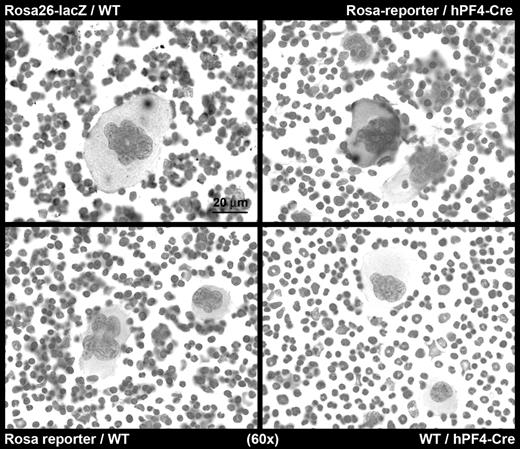Abstract
Here we report the first animal model with specific expression of Cre recombinase in megakaryocytes. Cre is an enzyme from bacteriophage-P1 that catalyzes reciprocal DNA recombination between pairs of loxP sites that results in excision of the DNA fragment located between them. The expression of Cre can be genetically manipulated by tissue specific promoters. When a tissue specific Cre mouse is crossed with a mouse line who has a gene flanked by loxP sites, the flanked gene can be deleted in a tissue specific manner. To target selective expression in megakaryocytes we used the promoter region of platelet factor-4 (PF4). The DNA transgenic construct consisted of the 387-bp of the promoter region of human PF4 (nucleotides −312 to +75) followed by the cDNA of Cre cloned at the start codon of the native gene, and the polyA sequence of the human β-globin gene. Transgenic animals were generated using routine pronuclear injection of fertilized oocytes. Transgenic mice were genotyped by a combination of Southern blot analysis and PCR. To evaluate functionality and tissue specificity of Cre expression, hPF4-Cre transgenic mice were crossed with ROSA26-lacZ reporter mice (B6.129S4-Gt(ROSA)26Sortm1Sor). In this reporter the cDNA for lacZ has been introduced into the Rosa26 locus preceded by an intervening sequence flanked by two loxP sites. In cells expressing Cre, recombination at the two loxP sites produces excision of the intervening sequence allowing the expression lacZ, thus β-galactosidase activity is a surrogate for Cre activity. β-galactosidase activity was analyzed by X-gal assay in megakaryocytes of bone marrow harvested from animals harboring the Cre transgene and reporter gene. We used the littermates that were either ROSA26-lacZ reporter/WT or WT/hPF4- Cre as negative controls, and Tg-ROSA26 (B6;129S-Gt(ROSA)26Sor), a strain that expresses lacZ in all tissues, as positive control. We have documented β-galactosidase activity that is present only in megakaryocytes and platelets in 6 established transgenic lines. In conclusion, we have generated megakaryocyte specific Cre mice using the promoter region of human platelet factor 4 (hPF4). Crossing this mouse with a loxP mouse will result in deletion of the loxP-flanked gene. This deletion will happen only in megakaryocytes. This tissue specific transgenic line is a powerful research tool for gene targeting experiments in platelets.
Author notes
Corresponding author


This feature is available to Subscribers Only
Sign In or Create an Account Close Modal